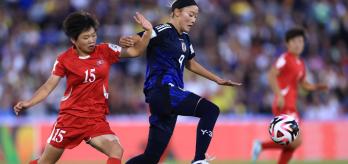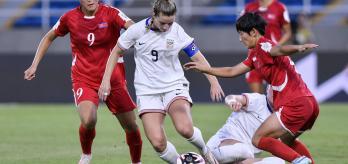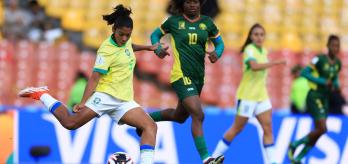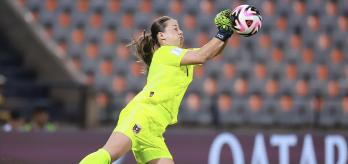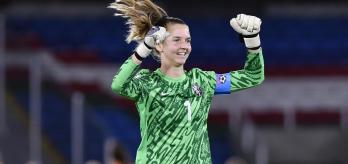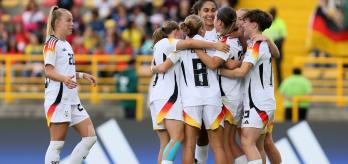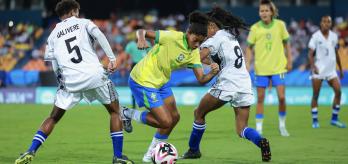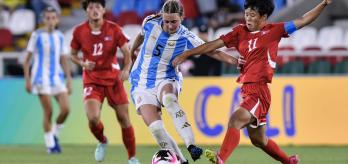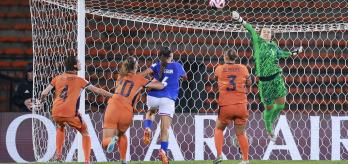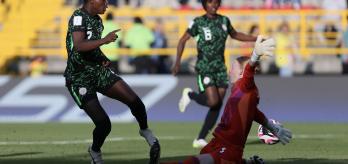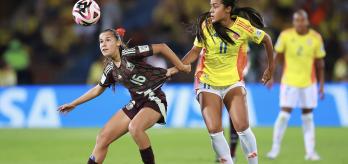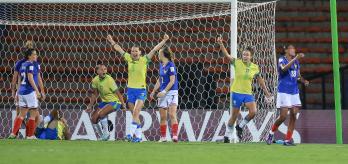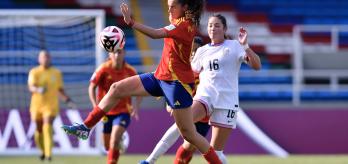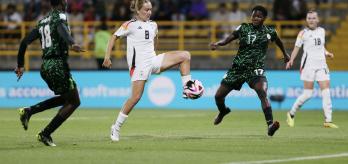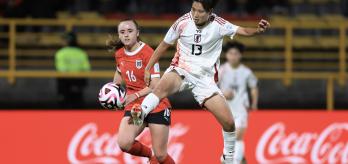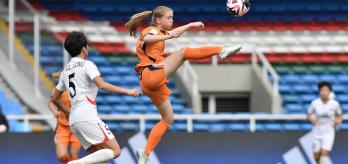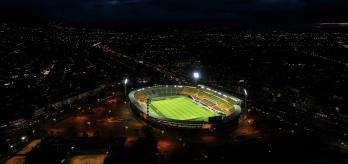In recent FIFA tournaments, it has been noted how difficult it can be to break down teams that are organised, compact and narrow when operating in mid and low defensive blocks. The central space has been prioritised for defending teams, opting to protect and deny access to this area of the pitch, with pressure designed to send the attacking team backwards or into the wide areas.
With limited space available inside the defending team’s shape, attacking sides have often had more success breaking lines by going around their opponents than going through them. However, a change in this trend was identified by our TSG during the FIFA U-20 Women’s World Cup Colombia 2024™ where the three medal-winning teams, Korea DPR (winners), Japan (runners-up) and the USA (third place) all proved to be very capable and successful at playing in tight spaces between opposition lines.
Korea DPR were ranked number one for receptions between the opposition’s defensive and midfield lines, averaging 133 per 60 minutes ball-in-play time. Japan were second with 128, while the USA averaged 114 (P60BIP). When we looked at receptions between these lines under pressure, all three teams were ranked in the top 10. Brazil were the top-ranked team with 86 per 60 minutes ball-in-play time.
TSG member Heather O’Reilly explains that, just because the three best teams received under pressure between the lines less than others, it doesn’t mean they couldn’t do it. In fact, their high levels of technical ability facilitated receptions that were not under pressure.
“We were really impressed with the technical skills displayed by players when receiving between the lines. Open body shapes, receiving on the back foot or the front foot depending on their orientation, and their ability to play high-quality passes with minimal touches meant some players’ movements to receive were just too quick for their opponents, and they could receive and progress the ball before pressure could be applied. It really struck me also how confident players were at playing the ball into team-mates who were operating in very tight spaces,” she explained.
When our Football Performance Insights Team explored the data on an individual player basis, the results were interesting, with all three adidas Gold, Silver and Bronze Ball winners, Choe Il-son (Korea DPR), Manaka Matsukubo (Japan), and Ally Sentnor (USA), all ranked high for progressing the ball successfully after receiving between the lines. Matsukubo was ranked number one in the tournament for receptions between the midfield and defensive line followed by a successful distribution with 214 throughout the tournament. Sentnor was second with 197 and Choe was fourth with 179. When we examined the player rankings for receptions between these lines followed by a successful line break, Matsukubo was top with 188, Sentnor was second with 168 and Choe was fourth with 128.
When we added in the pressure factor, Sentnor was ranked second with 121 receptions under pressure followed by a successful distribution, while Japan’s Maya Hijikata topped the rankings with 140. Colombia’s Linda Caicedo was third with 113, while Choe was fourth with 106.
Goals and goal chances from receptions between the lines
Crucially, important goal chances were created, and goals were scored following receptions between the midfield and defensive lines and again, when we explored the data, we started to see the impact of this tactic, particularly for the three teams that won medals. The USA’s forward, Ally Sentnor, had the highest number of receptions between the midfield and defensive lines that led to an attempt at goal, with 39. In fact, the top seven players in this metric all played for the medal-winning teams, with Sin Hyang and Choe (Korea DPR) ranked second and third, while Japan’s Hijikata and Matsukubo ranked fourth and fifth.
When we looked at goals scored that had receptions between the midfield and defensive lines in the possession sequence that led to the goal, Korea DPR’s prowess in this approach really came to the fore, with Choe, Sin and Jon Ryong-jong ranked as the top three players in the tournament.
Korea DPR striker Choe was exceptional when operating between the lines. The 17-year-old adidas Golden Ball winner displayed outstanding technical skill which defied her age, according to O’Reilly.
“She is one of the best young players I have ever seen, and her technical ability was hard to believe. The way she used her body to receive and protect the ball demonstrated an incredible level of game intelligence, but she could also keep the ball close and under control, meaning she had often progressed the ball before opposition defenders could get near her. When she was under pressure, she was calm, controlled, and able to move the ball quickly into great spaces. For such a young player, I was so impressed.”
In the clips below, our Technical Study Group have chosen some great examples of teams and players receiving between the lines in the possession sequences leading to attempts at goal and goals being scored.
In clip 1, Korea DPR’s striker, Choe Il-son (15) drops into the space between the lines, dragging the right-centre-back with her. This opens the space in behind for her team-mate, Sin Hyang (4), who Choe finds with a first-touch angled pass. Even though the Netherlands have two players close to her, she plays the ball before any direct pressure can be applied. The speed of play is a key part of why Korea DPR did not rank very high in receptions between the midfield and defensive lines under pressure.
Then, in clip 2, we see two receptions between the midfield and defensive lines in the possession sequence leading up to an attempt at goal. First, Colombia’s Linda Caicedo (18) plays forward to Karla Torres (15), who receives between the lines under pressure. With great technical skill, she changes direction, eliminating the two closest defenders and plays forward to the advancing Caicedo. Because the play has advanced, so too has the Netherlands’ defensive line, so Caicedo also receives the ball between the midfield and defensive lines before making an attempt at goal.
In clip3, the USA’s advanced midfielder, Yuna McCormack (18), gets into a great position to receive with her back foot between the lines under no pressure. This orientation and receiving technique opens up the right side of the pitch, away from the nearest opposition players, giving her the time to turn and advance with the ball before playing wide to her advanced right-back, Gisele Thompson (2). McCormack continues her forward movement and receives between the lines again before scoring.
Finally, in clip4, we see the constant movements of the USA’s forward, Ally Sentnor (9), before she eventually receives between the midfield and defensive lines. She is fully aware of the positioning of her team-mates and opposition players and knows exactly where she intends to play the ball before receiving it, meaning she can do so with a first-time pass. Even though there are a number of opposition players around her, she has two passing options and so her team-mates are confident to play into her. She continues to move and offer to receive, before receiving under no pressure between the lines for a second time. On this occasion, her body orientation is facing the goal, and she drives forward with intent before making an attempt at goal. In this instance, it is her constant movement that enables her to receive under no pressure.
Key take-aways
- Active movements to receive between the midfield and defensive line.
- Technically competent to receive under pressure and in tight spaces.
- Team-mates confident to play to players in tight spaces/under pressure.
- Body shape to protect the ball and progress it.
- Range of passing and dribbling skills to generate opportunities for attempts at goal.






